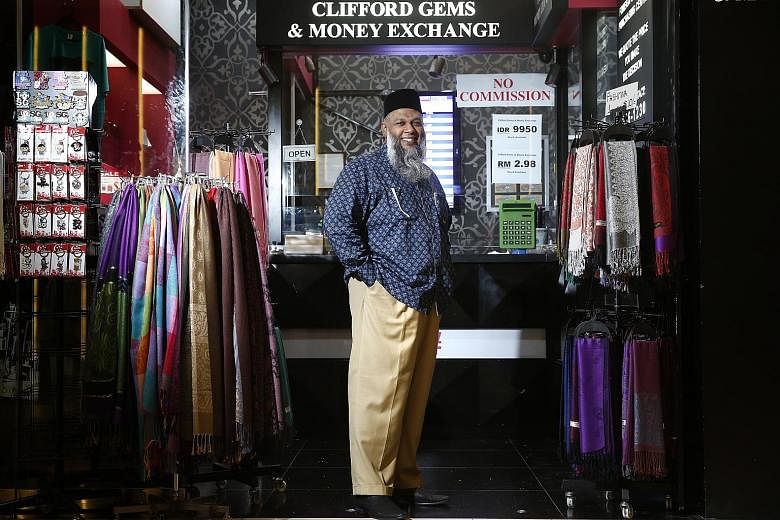Money changers here are finding it much harder to carve out a living amid rising competition, wafer-thin profit margins and the recent exchange rate volatility.
They also face more stringent regulations imposed by the Monetary Authority of Singapore (MAS).
A week ago, Malaysia's ringgit and Indonesia's rupiah were among currencies to rapidly lose value - creating greater uncertainty for money changers working on slim profit margins even in the best of times.
"Most of the money changers are worried because this is a customer-based business,"said Mr Mohamed Rafeeq, secretary of the Money Changers Association in Singapore and the owner of Clifford Gems & Money Exchange at Raffles City.
"It's difficult for us to change the price often because customers who don't understand how we work get angry (with us)."
He cited an example of facing a difficult time explaining to customers that he had to give them a lower ringgit rate when he ran out of stock and had to wait for a fresh batch of notes - as the rate changed in the interim.
Usually, Mr Rafeeq has one price for the ringgit for the entire day. However, owing to the recent demand for the ringgit as well as market fluctuations, there were instances when he had to refurbish his stocks - which meant that he could have three ringgit prices in a day.
Customers were angry that he was unable to sell them ringgit at the earlier, and more attractive, rate of RM3 for one Singdollar. Instead, they got a rate of RM 2.97.
Given the volatile market, Mr Rafeeq said the association is advising its members to be very careful when buying cash from customers.
With rates changing so quickly, money changers need to check the rates every time they buy from a customer and stick to the rate that was agreed upon, he said.
The problem is exacerbated when there are several money changers in the vicinity. Customers shop around and money changers try to undercut one another, Mr Rafeeq said. It ends up that some shops have long queues while others stand idle. But even the shops with the most customers make little or no profit, given the thin margins.
At Chinatown, a money changer, who asked to be known only as Mr Sirajudin, said in order to make a profit, money changers monitor forex rates closely and compare notes with rivals before fixing rates. "In different places in Singapore, there are different rates. But in Chinatown, the money changers will discuss first before adjusting the rates. Our rates will not really differ too much from one another's," said the veteran of 12 years.
Despite these friendly ties, competition is stiff owing to the increasing number of players in the industry. According to MAS figures, the industry has grown steadily, with 385 money changers operating now.
In the past, Indian Muslim money changers dominated, making up 95 per cent of the market. But more Chinese money changers have since set up shop, taking about 20 per cent of the market share.
Mr Rafeeq said some Chinese money changers learnt the trade from Indian Muslim counterparts.
"Usually people of one trade don't want to teach other groups the way they do things, but this is Singapore and we all help one another, we don't see race, we just see Singaporeans, so the (Indian Muslim) money changers taught them (the Chinese money changers)," he said.
Across the board, The Straits Times found that money changers are finding it more difficult to earn a living now than in the past. They cited various reasons - ranging from an increase in the licence fee to tighter regulations enforced by MAS.
Mr Rafeeq said that, in his father's time, the licence fee was $50. Now, it is $1,300 a year. He also added that "there was no compliance officer, no anti-money laundering" requirements in the past.
Mr Lam Chin Shin, 73, the owner of Toa Payoh Central Gold Hall Money Changer, who has been in the trade for 40 years, agrees.
"Ten years ago, it was very easy to run the business. There weren't that many money changers around and there weren't so many regulations that we have to follow."
Under MAS regulations against money laundering and terrorism financing, revised in April, money changers now have more paper work to complete.
Such controls include the need for money changers to identify and know their customers, to conduct regular account reviews and to report any suspicious transactions.
For example, Mr Lam said that he has to get the personal details of the customer if the transaction is above $5,000 and ask the customer a list of questions provided by MAS if the person wants to make a transaction of more than $20,000. His son, Mr Lam Jun Tang, 30, said money changers also have to attend additional anti-money laundering courses annually to upgrade skills.
Said a spokesman for MAS: "Financial institutions (FIs) are required to put in place robust controls to detect and deter the flow of illicit funds through Singapore's financial system." Under Singapore's regulations, money changers and other FIs are required to comply with revisions on the prevention of money laundering and countering the financing of terrorism.
These revisions are benchmarked against international best practices of the Financial Action Task Force, the global standard-setter for anti-money laundering measures.

